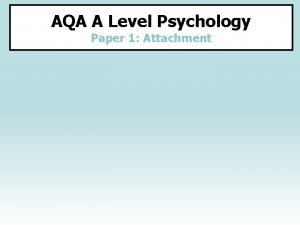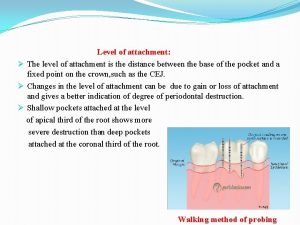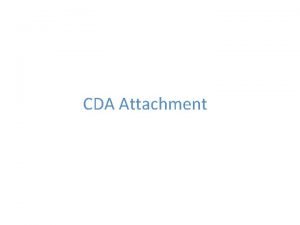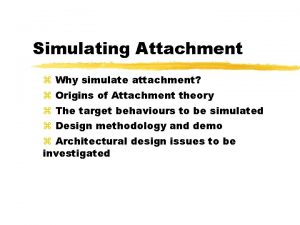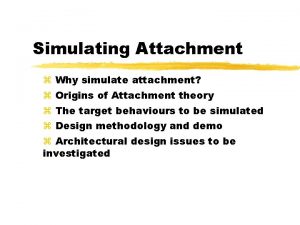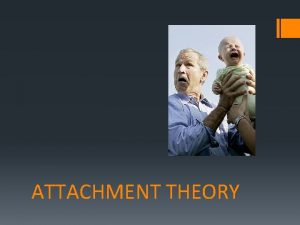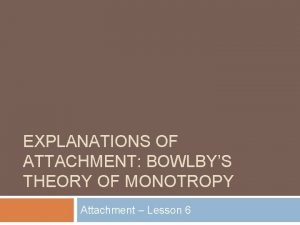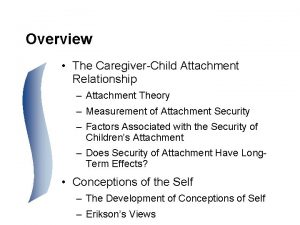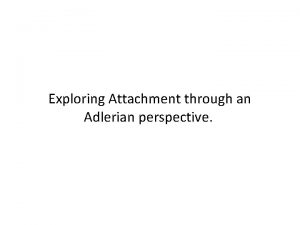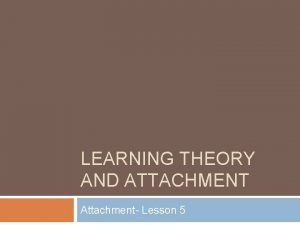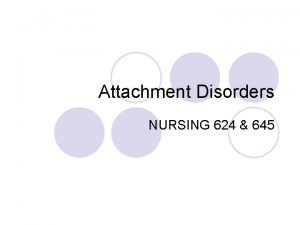Level of attachment The level of attachment is
































- Slides: 32

Level of attachment: Ø The level of attachment is the distance between the base of the pocket and a fixed point on the crown, such as the CEJ. Ø Changes in the level of attachment can be due to gain or loss of attachment and gives a better indication of degree of periodontal destruction. Ø Shallow pockets attached at the level of apical third of the root shows more severe destruction than deep pockets attached at the coronal third of the root. Walking method of probing

Determining the level of attachment Ø When the gingival margin is located on the anatomic crown, the level of attachment is determined by subtracting from the depth of pocket distance from the gingival margin to the cemento-enamel junction. Ø When the gingival margin is at the level of cementoenamel junction, the loss of attachment is equal to the pocket depth. Ø When the gingival margin is located apical to the cemento-enamel junction, the loss of attachment will be greater than the pocket depth, and therefore distance between cemento-enamel junction and the gingival margin should be added to the pocket depth. Walking method of probing

Walking method of probing Probing of a crater

ü ü ü Bleeding on probing: The insertion of periodontal probe to the bottom of the pocket produces bleeding if the gingiva is inflammed and the pocket epithelium is atrophic or ulcerated. Noninflammed sites rarely bleeds. In most cases bleeding on probing is an earlier sign of inflammation than gingival color changes. However color changes may present without bleeding on probing. Depending on the severity of inflammation, bleeding can vary from tenuous red line along the gingival sulcus to profuse bleeding If periodontal treatment is successful, bleeding on probing will stop.

Ø To test for bleeding after probing, the probe is carefully introduced to the bottom of the pocket and gently moved laterally along the pocket wall. Ø Sometimes bleeding appears immediately after removing the probe, and other times it may be delayed for a few seconds. Ø Therefore the clinician should recheck the bleeding 30 to 60 seconds after probing. Ø As a single test, bleeding on probing is not a good predictor of progressive attachment loss, however its absence is an excellent predictor of periodontal stability. Ø When bleeding is present in multiple sites of advanced disease, bleeding on probing is a good indicator of progressive attachment loss. Ø Insertion of a soft wooden interdental stimulator in the interdental space produces a similar bleeding response and can be used by the patient to self examine the gingiva for the presence of inflammation.

Profuse Bleeding on Probing Linear bleeding on probing

When to probe: q Probing of pocket is done at various times for diagnosis and for monitoring the course of treatment and maintenance. q The initial probing of moderate or advanced cases is usually hampered by the presence of heavy inflammation and abundant calculus and can not be done very accurately. q Probing at this stage is also difficult as the result of the discomfort and pain that occurs when the gingival tissues are inflammed. q The purpose of this initial probing together with the clinical and radiographic examinations is done to determine whether the tooth can be saved or extracted. q After the patient has performed adequate plaque control for some time and calculus has been removed and the major inflammatory changes disappear an accurate probing of the pocket can be performed.

ü For the determination of pocket depth or attachment levels to provide information on whether the lesion is in active or inactive state, measurements taken at different times have to be compared. Probing of pocket with stent in place

Ø Determination of disease activity: Ø Presently there are no any accurate method to determine activity or inactivity of a lesion. Ø Inactive lesions may show little or no bleeding on probing and minimal amount of gingival fluid. Ø Active lesions bleed more readly on probing and have large amounts of fluid and exudates. Ø Although active and non active sites may show no differences in bleeding on probing, even in patients with aggressive periodontitis. Ø The bacterial flora in healthy gingival sulcus, as revealed by dark field microscopy consists mostly of coccoid cells. Ø The bacterial flora of a periodontal pocket shows a greater number of spirochetes and motile rods.

Spirochetes & motile rods Coccoid cells

Florida probe Probing with Florida probe

Amount of attached gingiva: ü It is important to establish the relation between bottom of the pocket and the mucogingival line. ü The width of the attached gingiva is the distance between mucogingival junction and the projection on the external surface of the bottom of the gingival surface or the periodontal pocket. ü The width of the attached gingiva is determined by subtracting the sulcus or pocket depth from the total width of the gingiva(gingival margin to mucogingival line). ü This is done by streching the lip or cheek to demarcate the mucogingival line while pocket is being probed. ü The amount of attached gingiva is generally considered to be insufficient when streching of the lip or cheek induces movement of free gingival margin. ü Other method used to determine amount of attached gingiva include pushing the adjacent mucosa coronally with a dull instrument, or painting the mucosa with Schiller’s potassium iodide solution which stains keratin.

Alveolar bone loss: Ø Alveolar bone levels are evaluated by clinical and radiographic examination. Ø Probing is helpful for determining : 1. Height and contour of the facial and lingual bones obscured on the radiograph by dense roots. 2. The architecture of the interdental bone Ø Transgingival probing performed after the area is anesthetized, is a more accurate method of evaluation and provides additional information on bone architecture.

ü ü ü Palpation: Palpating the oral mucosa in the lateral and apical area of tooth may help to locate the origin of radiating pain that the patient can not localize. Infection deep in the periodontal tissues and the early stage of a periodontal abscess may also be detected. Suppuration: Abundant number of neutrophils present in the gingival fluids transforms into purulent exudate. Clinically the presence of exudate in a periodontal pocket is determined by placing the ball of the index finger along the lateral aspect of the marginal gingiva and applying pressure in a rolling motion towards the crown. Visual examination without digital pressure is not enough.

Ø Purulent exudate is formed in the inner pocket wall and therefore the external appearance may give no indication of its presence. Ø Exudate formation does not occur in all periodontal pockets, but digital pressure often rveals it in the pockets where its presence is not suspected.

Periodontal abscess: Ø A periodontal abscess is a localized accumulation of exudate within the gingival wall of periodontal pocket Periodontal abscess may be : 1. Acute 2. Chronic Acute periodontal abscess: ü It appears as an ovoid elevation of the gingiva along the lateral aspect of the root. ü The gingiva is edematous and red with a smooth shiny surface. Acute periodontal abscess

ü The shape and consistency of the elevate area vary: ü The area may be dome like and relatively firm, or pointed and soft. ü In most cases exudate may be expressed from the gingival margin with gentle digital pressure. Symptoms: Ø Acute periodontal abscess is accompanied by symptoms such as throbbing, radiating pain and tenderness of the gingiva to palpation. Ø Other symptoms may include sensitivity of the tooth to palpation , tooth mobility, and lymphadenitis, and less frequently systemic effects such as fever, lekocytosis and malaise. Ø Occationally the patient may have symptoms of an acute periodontal abscess without any notable clinical lesions or radiographic changes.

Chronic periodontal abscess: v It is usually present with a sinus, that opens onto the gingival mucosa along the length of the root. v There may be of a history intermittent exudation. v The orifice of the sinus may appear as a difficult to detect pinpoint opening, which when probed reveals a sinus tract leading deep into the periodontium. Chronic periodontal abscess

v The sinus may be covered by a small pink bead like mass of granulation tissue. v The chronic periodontal abscess is usually asymptomatic. v However the patient may complain episodes of dull, gnawing pain, slight elevation of the tooth, and adesire to bite down and gring the tooth. v Chronic periodontal abscess often undergoes acute exacerbatiobn with all the associated symptoms. Diagnosis: Ø The diagnosis of periodontal abscess require correlation of the history, and clinical and radiographic findings. Ø The suspected area should be probed carefully along the gingival margin in relation to each tooth surface to detect a channel from the marginal area to deeper periodontal tissues.

Ø Continuity of the lesion with the gingival margin is clinical evidence that the abscess is periodontal. Ø The abscess is not necessarily located on the same surface of the root as the pocket from which it is formed. Ø A pocket at the facial surface may give rise to a periodontal abscess interproximally. It is common for a periodontal abscess to be located at a root surface other than that along which the pocket originated because drainage is more likely to be impaired when a pocket follows a tortuous course. Ø In children a sinus orifice along the lateral aspect of a root is usually a result of periapical infection of a deciduous tooth. Ø In the permanent dentition such an orifice may be caused by a periodontal abscess as well as by periapical involvement.

The orifice may be patent and draining, or it may be closed and appear as red nodular mass. Exploration of such masses with a probe usually reveals a pinpoint orifice that communicates with an underlying sinus. Probing a periodontal abscess

Periodontal abscess and gingival abscess: The main difference between periodontal abscess and gingival abscess are location and history. The gingival abscess is confined to the marginal gingiva and it often occurs in previously disease free areas. It is usually an acute inflammatory response to forcing of foreign material into the gingiva. • The periodontal abscess involves the supporting periodontal structures and generally occurs in the course of chronic destructive periodontitis. Acute gingival abscess

Ø Ø Ø Periodontal abscess and periapical abscess: Following characterstics can be used as guideline to differentiate between periodontal abscess from that of periapical abscess. If the tooth is nonvital the lesion is most likely a periapical abscess. However a previously nonvital teeth can have a deep periodontal pocket that can become an abscess. Moreover a deep periodontal pocket can extend to the apex and cause pulpal involvement and necrosis. A periapical abscess may spread along the lateral aspect of the root to the gingival margin. However when the apex and lateral surface of root are involved by a single lesion that can be probed directly from the gingival margin, the lesion is more likely to have originated as a periodontal abscess.

v Radiographic findings are helpful in differentiating between periodontal and periapical lesions. v Early acute periodontal and periapical abscesses present no radiographic changes v Ordinarily a radioluscent area along the lateral surface of the root suggests the presence of periodontal abscess. v A radioluscent area at the apex of the root suggests periapical abscess. v Clinical findings such as the presence of extensive caries, pocket formation, lack of tooth vitality, and the existence of continuity between gingival margin and the abscess area often prove to be of greater diagnostic value than radiographic appearance.

A draining sinus on the lateral aspect of the root suggest periodontal rather than apical involvement. A sinus from a periapical leion is more likely to be located further apically. However sinus location is not conclusive. In many instances specially in children the sinus from a periapical lesion drains into the side of the root rather than at the apex.

Periodontal abscess Periapical abscess

Periodontal abscess Periapical abscess

MCQ 1. The image shown on the right side is: a. A periapical abscess b. Gingival abscess c. Periodontal abscess d. None of the above.

2. Radiographic picture on the right side shows: a. Periodontal abscess b. Periapical abscess c. Gingival abscess d. None of the above

3. which among the following lesions are genarally not seen in the radiograph. a. Periodontal abscess b. Gingival abscess c. Periapical abscess d. None of the above

4. Bacterial flora of periodontal pocket contains : a. Large number of coccoid cells b. Large number of spirochetes and motile rods c. Streptococcus and staphylococcus bacteria d. None of the above is true

5. In children a sinus orifice along the lateral aspect of the root is usually a result of: a. Periodontal abscess b. Periapical abscess c. Gingival abscess d. None of the above
 Psychology aqa a level spec
Psychology aqa a level spec Gingival attachment
Gingival attachment Biện pháp chống mỏi cơ
Biện pháp chống mỏi cơ Trời xanh đây là của chúng ta thể thơ
Trời xanh đây là của chúng ta thể thơ Phản ứng thế ankan
Phản ứng thế ankan Chó sói
Chó sói Thiếu nhi thế giới liên hoan
Thiếu nhi thế giới liên hoan Phối cảnh
Phối cảnh điện thế nghỉ
điện thế nghỉ Một số thể thơ truyền thống
Một số thể thơ truyền thống Thế nào là hệ số cao nhất
Thế nào là hệ số cao nhất Ng-html
Ng-html Sơ đồ cơ thể người
Sơ đồ cơ thể người Số nguyên tố là
Số nguyên tố là đặc điểm cơ thể của người tối cổ
đặc điểm cơ thể của người tối cổ Cách giải mật thư tọa độ
Cách giải mật thư tọa độ Các châu lục và đại dương trên thế giới
Các châu lục và đại dương trên thế giới Thang điểm glasgow
Thang điểm glasgow ưu thế lai là gì
ưu thế lai là gì Thẻ vin
Thẻ vin Tư thế ngồi viết
Tư thế ngồi viết Cái miệng bé xinh thế chỉ nói điều hay thôi
Cái miệng bé xinh thế chỉ nói điều hay thôi Các châu lục và đại dương trên thế giới
Các châu lục và đại dương trên thế giới Bổ thể
Bổ thể Từ ngữ thể hiện lòng nhân hậu
Từ ngữ thể hiện lòng nhân hậu Tư thế ngồi viết
Tư thế ngồi viết V cc cc
V cc cc Thơ thất ngôn tứ tuyệt đường luật
Thơ thất ngôn tứ tuyệt đường luật Bài hát chúa yêu trần thế alleluia
Bài hát chúa yêu trần thế alleluia Sự nuôi và dạy con của hươu
Sự nuôi và dạy con của hươu Diễn thế sinh thái là
Diễn thế sinh thái là đại từ thay thế
đại từ thay thế Vẽ hình chiếu vuông góc của vật thể sau
Vẽ hình chiếu vuông góc của vật thể sau
